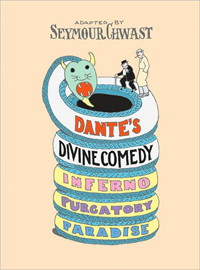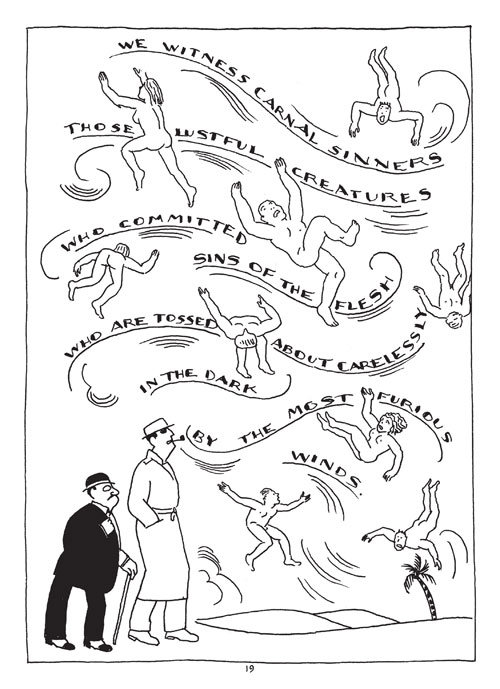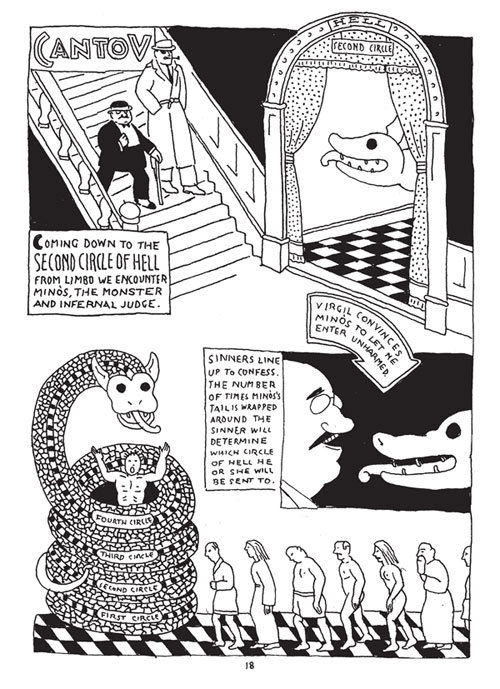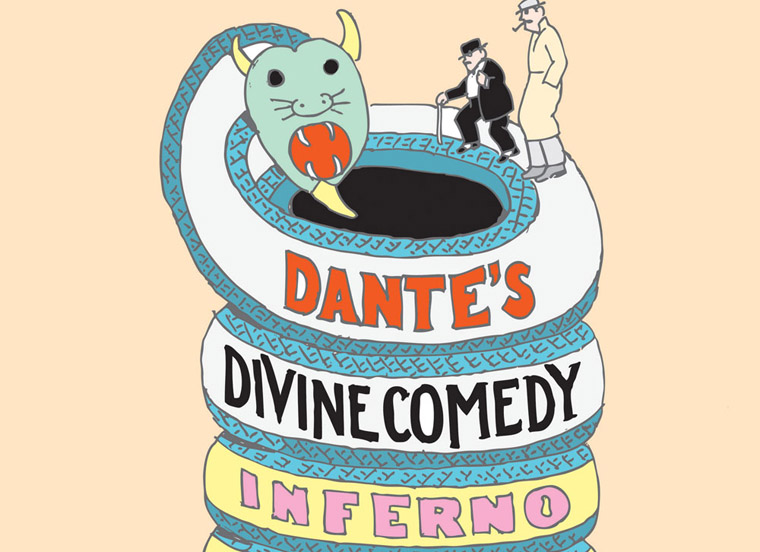 Seymour Chwast: Divine Comedy (Bloomsbury, 9/2010)
Seymour Chwast: Divine Comedy (Bloomsbury, 9/2010)
What happens when you drop a noir hero into a 14th Century Italian epic? Seymour Chwast’s stylish and intriguing graphic-novel version of Dante‘s Divine Comedy provides an answer. Chwast combines dynamic illustration and easily understandable prose to give the epic a fresh new look and an unlikely appeal for non-academic readers. Those of us uninterested in centuries-old religious poetry will be delighted, but readers familiar with the original will find even more to love.
Chwast’s story closely follows Dante’s original epic, in some respects more than others. His Dante, imagined here as a noir detective, joins guide Virgil to discover the perils of the underworld, the meaning of God’s justice, and, in this case, lots of flappers. The author, now sporting a trenchcoat and smoking an ever-present pipe, regards the horrors of hell with all the hard-boiled eyes of a Dashiell Hammett hero, explaining away punishments with all of the original Dante’s stoic resolve.
Pages of Italian poetry are here reduced to a pithy comment. Virgil, dressed as a 1930s businessman, is the knowledgeable guide to Dante’s seeker of truth and leads Dante through hell and purgatory. His lady-love/moll, Beatrice, accompanies him through paradise and into the sight of God. The details make for a wonderfully irreverent look at a classic of European literature.
 Depictions of Dante’s famously labyrinthine version of hell are recast as a carnival-esque hall of terrors. The 1930s aesthetic prevails throughout, with mob bosses and fedora hats on every page, but Chwast is nothing if not inventive. His visions of the sinners resemble New Yorker cartoons from, well, hell. His harpies, lustful couples, wrathful wrestlers, and the rest are all rendered with care but also with a sense of fun. Chwast moves quickly through each canto, leading to some humorous simplifications, charts, and diagrams to move his adaptation along.
Depictions of Dante’s famously labyrinthine version of hell are recast as a carnival-esque hall of terrors. The 1930s aesthetic prevails throughout, with mob bosses and fedora hats on every page, but Chwast is nothing if not inventive. His visions of the sinners resemble New Yorker cartoons from, well, hell. His harpies, lustful couples, wrathful wrestlers, and the rest are all rendered with care but also with a sense of fun. Chwast moves quickly through each canto, leading to some humorous simplifications, charts, and diagrams to move his adaptation along.
Artistically, the novel is undeniably beautiful, with clean lines and attention to detail throughout (like the “Caution: Frozen Lake” sign at the center of hell), but Chwast’s strength lies in the layout and design of his novel. He progresses through the cantos with an eye for order befitting an orderly heaven and hell, but each page has some new delight, like an inventive sidebar or a different arrangement of panels. A giant will take up two whole pages, while many scenes of sinners are simply a repeated pattern of lustful or violent bodies. A longtime legend in the design world, Chwast’s first graphic novel is, unsurprisingly, a marvel of clean and creative aesthetics.

This adaptation lacks the poetic power of Dante’s original, aside from a few moments (on the final page, an awestruck Dante looks at the stars and says, “At this point, power failed high fantasy, but like a wheel in perfect balance turning, I felt my will and my desire impelled by the love that moves the sun and other stars”), but Chwast makes up for it mightily in fun and readability. Dante’s seemingly endless catalog of punishments and personal grudges unfold in quick and succinct succession, to the pleasure of new readers and the amusement of old. Chwast’s artistic prowess will delight both.

